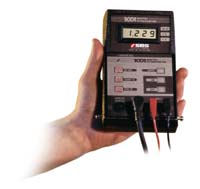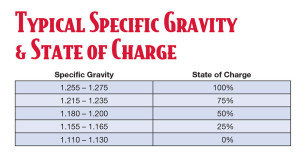On the first day of every month (more or less, weather permitting) I go around to all the battery banks I’m responsible for and top off their electrolyte levels. That has grown to a total of 48 storage batteries or 144 separate cells, so mostly I hop right along to get it done. It used to be a real chore until a few years ago when I learned – as I so often do with gulchy chores – that I was doing it completely wrong. I spent $8.50 on one of these…

…and things sped up substantially.
Normally on Battery Day that and a physical inspection is all I do. If there’s something out of the ordinary, I fix it or (more often) report it. I don’t get more proactive unless a whole system starts having behavior problems.
Such as…That fellow who’s been staying at Former Neighbor J’s old place has been complaining that ever since he turned on the refrigerator in the house, he’s been losing power halfway through evenings. That system isn’t huge or of world-class quality, but it should do better than that. So, in the interest of demonstrating why people should keep paying me to do this sort of thing, this morning before making my rounds I went into my powershed and dusted off another piece of equipment I don’t actually use much…

That’s an old digital hydrometer*, and I’m not quite sure where it came from. I only suspect who originally owned it but he never really lived here and hasn’t been around for seven years, so by squatter’s rights I guess it belongs to Landlady. Of course since I’m the only one who ever uses it…
(ahem) Anyway, I took it out and tested it on my own batteries this morning, which is good because the 9-volt battery in the tester had gone dead. Swapped out the battery, and my not-yet-charged storage batteries were reading a specific gravity of around 1.24 in all cells. Which ain’t bad for eight in the morning…

Took it over to the Former Neighbor J Place, pulled off the caps, fired up the hydrometer (and by the way this is a job where you really do want that rubber apron, and the gloves, and the eyepro, and I really did use them, so thank you) and in the very first cell I tested I got a reading of 1.04.
That’s also the reading I got in cells 2-18.
Which, lest you miss the point, is not good.
I walked across the plaza, went into the shed where rest the secondary battery bank which has its own solar cells, charge controller and inverter. And there, to my total perplexity, I got the same readings.
Yes, I tested the hydrometer before going in my rounds, but it’s an old seldom-used tool and I had to wonder if it was reading accurately. So I jumped in the Jeep and drove to Ian’s Underground Powershed…

…and every cell I tested in his fully-charged battery bank read over 1.27. So there’s nothing wrong with the tool.
I’m going to go back and re-test them this afternoon, but those batteries were dead flat discharged at nine in the morning and that ain’t right. What I don’t understand is why both completely separate battery banks, one of which has no load on it, were discharged.
—
*And by the way, if you’re only familiar with those battery hydrometers from the auto parts store that look like turkey basters, like I used to be, this is worlds different.
















































Whatever the problem is, it shouldn’t be too hard to diagnose. Are all the batteries the same brand and the same age? If so they may simply have all aged out together. Whatever the problem is, it’s likely been there for a while and has only made itself known because of the power demands of the new occupants.
When you have parallel battery strings, one or two bad cells can drag the whole bank down. If the issue isn’t quickly noticed, then none of the batteries gets a proper charge, which can $ulfide them all.
We will be interested to hear “The rest of the story”.
Agreed – I was expecting to find a couple of bad cells. But all the batteries being discharged almost certainly means the problem isn’t in the batteries at all. They’re not being charged.
I do think it’s fairly new, though, or I’d have caught it before. One thing I didn’t mention is that, having taken off all the cell caps, I didn’t see any bubbling activity. That’s new.
If it’d not bubbling, then the rate of charge is too low. Any of the connections come loose prior to the split?
Are there fuses between the panels and the batteries? We had a bunch of issues with fuses in our system over the years. Mouses in the wiring? Could there be a setting out of whack telling the inverter to invert but not to charge? An array switch or circuit breaker accidently turned off? With new people in there, they could have made some “adjustments” without knowing what they were doing.
I first inclination would be to check the connections from the panels right on down through the charge controller then check the controller to see how well it’s working but in reality this is one area where my skill set is totally lacking. Hell these days I’m having the devil’s own time figuring out a trailer wiring issue. I’m looking forward to seeing how you resolve this.
Oh, I’m going to resolve it by making sure they’ve got the contact info for our resident expert. Which isn’t me. There’s a guy who normally deals with this stuff, he’s the one who sold these batteries, but I have questions about his…um…
Fortunately New Full-Time Neighbor S is now here more nearly full-time, he does it for a living, and I’m going to ask him if he’s interested.